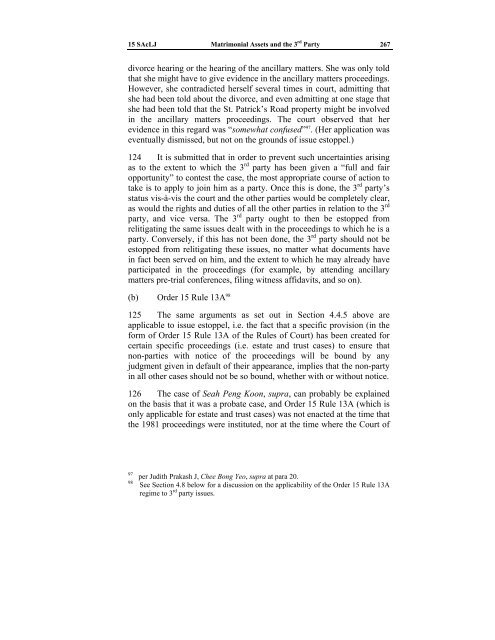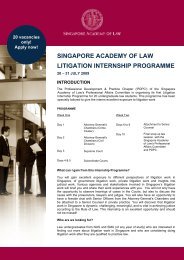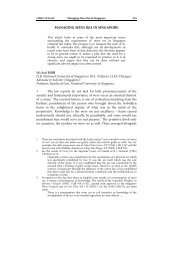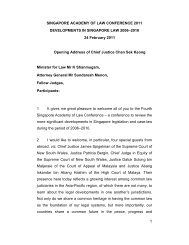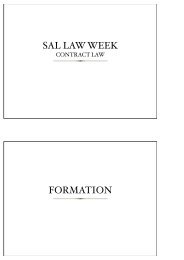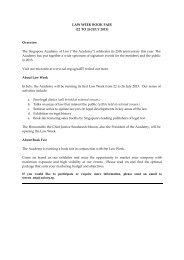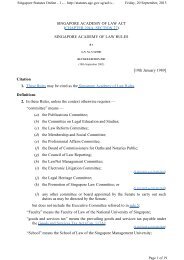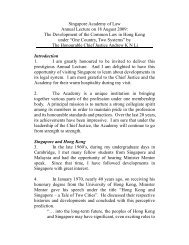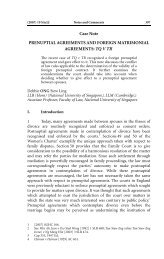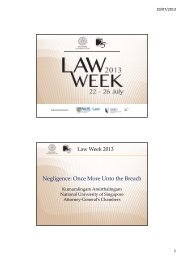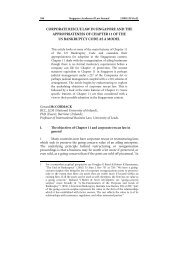View Article - Singapore Academy of Law
View Article - Singapore Academy of Law
View Article - Singapore Academy of Law
Create successful ePaper yourself
Turn your PDF publications into a flip-book with our unique Google optimized e-Paper software.
15 SAcLJ Matrimonial Assets and the 3 rd Party 267<br />
divorce hearing or the hearing <strong>of</strong> the ancillary matters. She was only told<br />
that she might have to give evidence in the ancillary matters proceedings.<br />
However, she contradicted herself several times in court, admitting that<br />
she had been told about the divorce, and even admitting at one stage that<br />
she had been told that the St. Patrick’s Road property might be involved<br />
in the ancillary matters proceedings. The court observed that her<br />
evidence in this regard was “somewhat confused” 97 . (Her application was<br />
eventually dismissed, but not on the grounds <strong>of</strong> issue estoppel.)<br />
124 It is submitted that in order to prevent such uncertainties arising<br />
as to the extent to which the 3 rd party has been given a “full and fair<br />
opportunity” to contest the case, the most appropriate course <strong>of</strong> action to<br />
take is to apply to join him as a party. Once this is done, the 3 rd party’s<br />
status vis-à-vis the court and the other parties would be completely clear,<br />
as would the rights and duties <strong>of</strong> all the other parties in relation to the 3 rd<br />
party, and vice versa. The 3 rd party ought to then be estopped from<br />
relitigating the same issues dealt with in the proceedings to which he is a<br />
party. Conversely, if this has not been done, the 3 rd party should not be<br />
estopped from relitigating these issues, no matter what documents have<br />
in fact been served on him, and the extent to which he may already have<br />
participated in the proceedings (for example, by attending ancillary<br />
matters pre-trial conferences, filing witness affidavits, and so on).<br />
(b) Order 15 Rule 13A 98<br />
125 The same arguments as set out in Section 4.4.5 above are<br />
applicable to issue estoppel, i.e. the fact that a specific provision (in the<br />
form <strong>of</strong> Order 15 Rule 13A <strong>of</strong> the Rules <strong>of</strong> Court) has been created for<br />
certain specific proceedings (i.e. estate and trust cases) to ensure that<br />
non-parties with notice <strong>of</strong> the proceedings will be bound by any<br />
judgment given in default <strong>of</strong> their appearance, implies that the non-party<br />
in all other cases should not be so bound, whether with or without notice.<br />
126 The case <strong>of</strong> Seah Peng Koon, supra, can probably be explained<br />
on the basis that it was a probate case, and Order 15 Rule 13A (which is<br />
only applicable for estate and trust cases) was not enacted at the time that<br />
the 1981 proceedings were instituted, nor at the time where the Court <strong>of</strong><br />
97<br />
98<br />
per Judith Prakash J, Chee Bong Yeo, supra at para 20.<br />
See Section 4.8 below for a discussion on the applicability <strong>of</strong> the Order 15 Rule 13A<br />
regime to 3 rd party issues.


